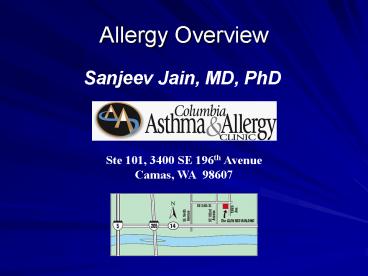Allergy Overview - PowerPoint PPT Presentation
1 / 25
Title:
Allergy Overview
Description:
... dead skin or dander which becomes airborne and sticks to clothing and furniture. ... All patients who have a systemic reaction to an insect sting. ... – PowerPoint PPT presentation
Number of Views:107
Avg rating:3.0/5.0
Title: Allergy Overview
1
Allergy Overview
Sanjeev Jain, MD, PhD
Ste 101, 3400 SE 196th Avenue Camas, WA 98607
2
There are two arms to the immune response to any
foreign substance (antigen) entering the
bodythe innate immune responsethe adaptive
immune response
3
- Innate Immune Response
- rapidly deployed - first line defense
- encoded in genome - conserved from flies to
humans - broad recognition of microbialpatterns
- no memory of past encounter with antigen
4
- Adaptive Immune Response
- exquisitely specific recognition
- of millions of different potential antigens
- requires gene rearrangement to generate
- antigen specific receptors
- long-term memory of past antigen
- encounter
5
Antigen specific receptors onT cells and B cells
characterize the adaptive immune response.T
cells - cell mediated immunityB cells -
antibody mediated (humoral) immunity
6
Two Arms of Cell Mediated Immunity
- There are two types of T-cells
- Th1 and Th2.
- Th1 cells produce mediators that stimulate the
immune system responsible for defense against
intracellular pathogens. - Th2 cells stimulate the defense against
extracellular pathogens and parasites. - Th2 cells are also responsible for allergies.
7
Most immune responses have both a Th1 and Th2
component. The T cell response to some
infectious agents becomes polarized to one Th
subset.
Degree of polarization
Th 2
Th2
Th1
Th 1
Helminthic Parasites (worms)
Bacteria (tuberculosis) Viruses (measles)
Helminthic parasites
Gram - negative bacteria
8
How is an Allergic Reaction Triggered?
9
What is Asthma
- Airway Obstruction
- Airway Hyper-reactivity
- Allergic Inflammation
- Mucus Secretion
10
The Hygiene Hypothesis
Allergy and asthma have increased during the last
20-50 years due to reduced exposure to childhood
bacterial and viral infections brought about by
improvements in vaccination and sanitation. In
the absence of these Th1 polarizing stimuli
mucosal immune responses fail to overcome their
inherent Th2 bias and become slanted in the
direction of allergy.
11
(No Transcript)
12
The relationship between infection and allergic
disease
In developing countries Low incidence of
allergic disease High incidence of infectious
diseases (Th1) High infection with worms
(helminths)
In developed countries High incidence of
allergic disease Low incidence of infectious
diseases (Th1) Low infection with worms
(helminths)
Allergic disease (Th2)
Helminth Infection (Th2)
Microbial Infection (Th1)
13
(No Transcript)
14
(No Transcript)
15
(No Transcript)
16
Common Indoor Aeroallergens
- Dust Mites
- Microscopic Insects that live in all bedding,
padded furniture, and carpet. They feed on dead
skin or dander, and get water from humidity - Mold
- Mold grows in all high humidity environment.
- Pet Dander
- All mammals and birds shed dead skin or dander
which becomes airborne and sticks to clothing and
furniture.
17
Common Outdoor Allergens
- Tree Pollens
- Commonly present in spring between February to
May - Grass Pollens
- Commonly present in summer between April to
August - Weed Pollens
- Commonly present in fall between August to
October
18
Allergies can be controlled three ways
Avoid the allergens, the things youre
allergic to Treat the symptoms with
medications Stop the allergic reaction
with allergy shots, also known as
immunotherapy
Some of the most exciting and hopeful advances
are taking place in immunotherapy.
19
(No Transcript)
20
(No Transcript)
21
(No Transcript)
22
(No Transcript)
23
Qualifications of An Allergist
- A physician who has received residency training
in one of the primary care specialties. - Following residency he/she has received 2-3 years
of training in an accredited allergy fellowship
training program. - Allergists are expected to undergo rigorous
testing to qualify for certification by the
American Board of Allergy and Immunology. - Allergists are experts in clinical immunology,
pathophysiology of rhinitis and sinusitis
asthma, allergic conjunctivitis, urticaria,
angioedema, anaphylaxis, atopic dermatitis, food
allergy, medication allergy, stinging insect
allergy, latex allergy, mastocytosis,
eosinophilic syndromes, aerobiology, and
immunodeficiency.
24
Who Should Receive An Allergy Consultation
- A patient whose seasonal or perennial rhinitis,
sinusitis, or conjunctivitis is not in adequate
control with standard medications alone. - All asthma patients should receive consultation
by an allergist at least once to determine if
environmental control measures or immunotherapy
can benefit them. - All patients with moderate to severe asthma
should receive at least yearly evaluation by an
allergist or pulmonologist to ensure that their
asthma is stable and optimal therapy is
instituted. An allergist can also offer
specialized therapy such as Xolair to these
patients. - All patients with chronic, recurrent, or
difficult to treat urticaria or atopic
dermatitis.
25
Who Should Receive An Allergy Consultation
Conted.
- All patients with angioedema or anaphylaxis of
unknown etiology. - A patient who needs to have a definitive
diagnosis of a food allergy, or wishes to be
educated about his/her food allergy. - A patient whose diagnosis of a medication allergy
is uncertain, or someone who needs to be
desensitized to a medication that he/she is
allergic to. - All patients who have a systemic reaction to an
insect sting. - Any patient who requires evaluation or treatment
of latex allergy. - All patients with mastocytosis, eosiniphilic
syndromes, and other rare allergy-related
illnesses. - Any patient with recurrent or life-threatening or
uncommon infections.

